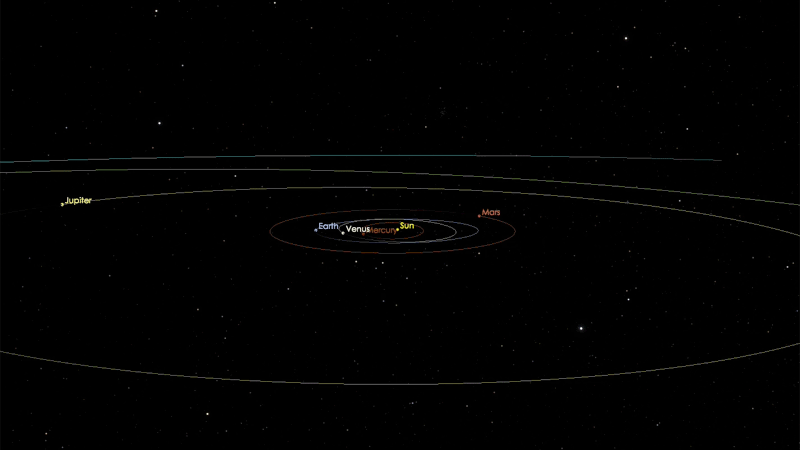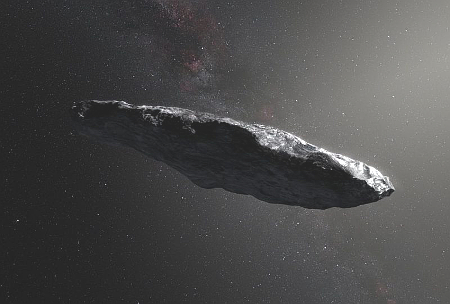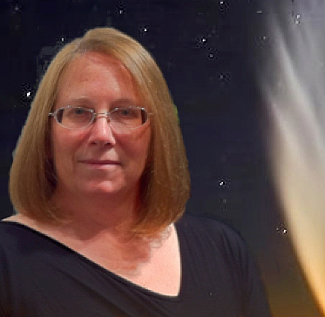|
Print version |
|
First known interstellar visitor drops by |
|
November 21, 2017 |
 |
| This animation shows the path of
`Oumuamua, as it passed through our
inner solar system in September and
October 2017. Image via
NASA/JPL-Caltech. |
|
By Deborah Byrd
EarthSky
 |
| This
artist’s impression shows the 1st
interstellar asteroid, which has been
named `Oumuamua. Data analysis reveals
that is is a dark red highly-elongated
metallic or rocky object, about 400
meters long, unlike anything normally
found in our solar system. Image via
ESO/ M. Kornmesser. |
A few weeks ago, EarthSky reported on a small
object visiting from beyond our solar system.
Now astronomers have scrutinized data from this
object, which has been given the name "'Oumuamua,"
and which must have traveled through space for
millions of years before its chance encounter
with our star system.
The conclusion is that it’s a dark, reddish,
highly-elongated rocky or high-metal-content
object. And, indeed, it is the first known
asteroid from interstellar space. These new
results were published November 20 in the
peer-reviewed journal Nature.
Some astronomers thought the object was a comet
when the Pan-STARRS 1 telescope in Hawaii first
picked it up on October 19, as a faint point of
light moving across the sky. Others thought it
looked like a typical fast-moving small
asteroid.
As they tracked its motion through space,
astronomers began to be able to calculate its
orbit, showing beyond any doubt that this body
did not originate from inside our solar system,
like all other asteroids or comets ever
observed.
Instead, this object was doubtless from
interstellar space.
Observations revealed no signs of cometary
activity after it passed closest to the sun in
September 2017. It has now been reclassified as
an interstellar asteroid – the first ever
observed – and named 1I/2017 U1 (`Oumuamua). A
statement from the Institute for Astronomy (IfA)
at the University of Hawaii described the
intricacies of naming this object:
"Originally denoted A/2017 U1 (with the A for
asteroid), the body is now the first to receive
an I (for interstellar) designation from the
International Astronomical Union, which created
the new category after the discovery. In
addition, it has been officially given the name
`Oumuamua. The name, which was chosen in
consultation with Hawaiian language experts
Ka`iu Kimura and Larry Kimura, reflects the way
this object is like a scout or messenger sent
from the distant past to reach out to us (`ou
means “reach out for”, and mua, with the second
mua placing emphasis, means 'first, in advance
of')."
But all of that – name, designations,
characterizations of the object – came later.
First, astronomers had to observe it and try to
understand just what this speedy visitor to our
solar system might be. And they had to do it
quickly. By the time earthly telescopes first
noticed it, `Oumuamua had already passed its
closest point to the sun, and was heading back
into interstellar space.
 |
| Karen Meech |
An international team lead by astronomer Karen
Meech of IfA observed the object. They gathered
data from telescopes around the world, including
the Canada-France-Hawaii Telescope (CFHT), the
United Kingdom Infrared Telescope (UKIRT) and
the Keck Telescope on Maunakea, the Gemini South
telescope, and the European Southern Observatory
(ESO) Very Large Telescope (VLT) in Chile. These
observations led to detailed measurements of the
visitor’s properties.
"This thing is very strange," Meech said. "What
we found was a rapidly rotating object, at least
the size of a football field, that changed in
brightness quite dramatically. This change in
brightness hints that `Oumuamua could be more
than 10 times longer than it is wide – something
which has never been seen in our own solar
system.
"`Oumuamua does have some similarities to small
objects in the outer solar system, especially
the distant worlds of the Kuiper Belt – a region
of rocky, frigid worlds far beyond Neptune.
While study of `Oumuamua’s colors shows that
this body shares characteristics with both
Kuiper Belt objects and organic-rich comets and
trojan asteroids, its hyperbolic orbit says it
comes from far beyond."
Meech also said the object has:
"… a dark red color, similar to objects in the
outer solar system, and [we] confirmed that it
is completely inert, without the faintest hint
of dust around it."
The astronomers said these properties suggest
that `Oumuamua is dense, possibly rocky or with
high metal content, lacks significant amounts of
water or ice, and that its surface is now dark
and reddened due to the effects of irradiation
from cosmic rays over millions of years.
It is estimated to be at least 400 meters long.
At first – by looking backwards along the orbit
that had been calculated for `Oumuamua –
astronomers might have said the object had come
from the approximate direction of the bright
star Vega, in the northern constellation Lyra
the Harp.
Things aren’t that simple, though, in our Milky
Way galaxy, where everything is always moving.
Although it’s travelling about 60,000
miles/hour, `Oumuamua has taken so long to
journey to our solar system that Vega was not
near that position when the asteroid was there
about 300,000 years ago.
According to astronomers:
"`Oumuamua may well have been wandering through
the Milky Way, unattached to any star system,
for hundreds of millions of years before its
chance encounter with the solar system."
In fact, astronomers were expecting to find an
object like this one. They estimate that an
interstellar asteroid similar to `Oumuamua
passes through the inner solar system about once
per year. We haven’t seen them before because
they are so faint and hard to spot. But recent
survey telescopes, such as Pan-STARRS, are
powerful enough to discover them.
That’s why team member Olivier Hainaut of
European Southern Observatory commented:
"We are continuing to observe this unique
object, and we hope to more accurately pin down
where it came from and where it is going next on
its tour of the galaxy. And now that we have
found the first interstellar rock, we are
getting ready for the next ones!"
Deborah Byrd created the EarthSky radio
series in 1991 and founded EarthSky.org in 1994.
Today, she serves as Editor-in-Chief of this
website.
She has won a galaxy of awards from the
broadcasting and science communities, including
having an asteroid named 3505 Byrd in her honor.
A science communicator and educator since 1976,
Byrd believes in science as a force for good in
the world and a vital tool for the 21st century.
"Being an EarthSky editor is like hosting a big
global party for cool nature-lovers," she says. |
|
Questions or comments about this
article?
Click here to e-mail! |
|
|
|
|

